Welcome to ‘Hotel Website Copywriting – The Definitive Guide’, the most comprehensive guide to hotel website copywriting you’ll find anywhere.
Just to be clear: we won’t go into crazy detail about grammar and sentence structure, creative inspiration, or other boring/woo-woo things that won’t help you with your hotel website.
Instead, you’re going to learn what hotel website copywriting is all about on a practical and easy-to-understand level, so you can get your basics down, apply them to your site and convince more of your site visitors to book direct.
Because honestly: hotel website copywriting can be quite easy (and even fun) with the right guidance.
So, if you’re looking to give your hotel the awesome website it deserves and are ready to boost direct bookings, this Definitive Guide to Hotel Website Copywriting is for you!
One more thing before we dive in: bookmark this guide. That way you can come back every time you’ve implemented key takeaways and are ready for the next section.
Now, let’s get started!
No time to read the whole guide now? Download it for later! 👇🏼
Hotel Website Copywriting – The Definitive Guide
How does your hotel website make site visitors feel? – A quick exercise
Picture this: It’s been a while since your last vacation, so you’re looking for the perfect place to spend some quality time and relax.
During your research, you’ve found a few hotels that fit your needs. Now it’s time to make the final decision and pick one.
While the properties’ listings on various booking engines give you some good info, you want to get a better feel for each hotel, so you head to their website.
The first website is hard to navigate. Information is difficult to find. You can’t get answers to your questions. The texts are boring, cumbersome and full of typos.
You give up frustrated and disappointed and head to the next hotel’s website.
The photos look nice and you find most of the information you need. But somehow, the descriptions are ‘bla’ and the ‘wow-factor’ is missing. In the end, you don’t feel excited about your stay there, even though the hotel looks ‘ok’.
You decide to check the next property on your list.
As soon as you load the website, you get a feeling that this is the one. Their photos are fantastic and highlight exactly the things you want and need at the hotel.
You scroll through and feel like the texts and descriptions were written just for you. All the details you want to know are easy to find, so you get an answer to your questions in the blink of an eye. And finally, you see yourself spending an amazing time at this hotel, enjoying your well-deserved time off.
You click through and are amazed at how easy and hassle-free it is to book. Before you know it, your room is reserved, and you browse the site once more because you’re excited you found the perfect place to stay.
Now, here’s my question for you: which of the scenarios above does your hotel website create for your website visitors?
If you can’t confidently say “It’s the last scenario because people love my hotel’s website and we get a lot of direct bookings” then it’s time to revamp your hotel website and update your hotel website copy.
That way you can make a better first impression on your potential guests, boost your direct bookings, spend less money on OTA commissions and keep more revenue for your property.
What is hotel website copywriting?
First things first…
When people find out I’m a copywriter, they often ask what that means.
Well, here’s the dictionary’s definition of copywriting: the activity or occupation of writing the text of advertisements or publicity material.
The term ‘advertisements’ is clear, but ‘publicity material’ is a much broader term. It covers everything you can use to promote or inform people about your business.
For a hotel, copywriting includes:
- Hotel websites
- Room, property and amenity descriptions
- Confirmation email content
- Newsletters
- Blog posts
- Press releases
- Social media captions
- Pay-per-click ads
- Posters and flyers
- and all other forms of content and communication you use to spread the word
Now, you probably realize that copywriting is around you everywhere you go, and you’ve probably done it for your own business many times.
While copywriting has many faces, we’ll look specifically at hotel website copywriting, how you can use it to improve your hotel website’s performance and get more direct bookings.
Why even bother with copywriting?
You know what they say about first impressions – you can only make them once, and they usually stick.
That’s why it’s so important to present your hotel properly and make a strong, lasting impression on your site visitors, especially the first-timers.
The best way to do that, apart from having a clear layout with beautiful photos, is to use strong, engaging texts that resonate with and speak to your ideal guest. That way you can generate interest in your property and what you offer, and convince guests to stay with you.
In short: Good hotel website copy can bring you more direct bookings.
Hotel website copywriting: Three things you need to know before starting
There are three important things you need to understand about the internet and how your future site visitors use it before we look at how to write hotel website copy.
Once we’ve gone over that, you’ll have an easier time writing powerful texts that charm your target audience and encourage them to book.
1. The internet is user-centric
Mediums like magazines, radio or TV don’t require user input. They offer content that can be consumed passively.
The internet is a whole different creature. Look at the most popular pages and platforms today: Facebook, Instagram, YouTube, TikTok and forums (like Reddit). They allow and encourage people to create, contribute, engage and interact. Users actively participate because the content is about, by and for them.
Embrace this idea on your hotel website and make it about your guests. Sure, you need to talk about your hotel and what it has to offer but always do it with the guest in mind. Everything you put on your website must be there for the guest, not for you.
Think about it this way: who is the most important person in your hotel? Exactly, the guest. So why not also make them the most important person on your website?
2. People are very vocal online
Your website and online presence are yours and you can design them the way you want, to create a certain image of your property. But be careful: your audience will hold you accountable and expect you to deliver on your promises.
This can go two ways. If you provide the great experiences and amenities you promised, your guests will become your best (free) marketers. If you overpromise and underdeliver, be ready for negative publicity on TripAdvisor or other review sites and a damaged reputation.
The moral of the story: only make promises you can keep and try to overdeliver whenever possible.
3. People come to your site with a goal in mind
People go to websites with a clear goal in mind. Take yourself as an example. You probably only visit sites for a specific reason like getting information, buying something, or being entertained. If a site doesn’t help you reach your goal, you leave and try another one.
The same is true for hotel website visitors. They come to your site to complete a task. This could include gathering information about your property, checking rates and availability, and making a booking.
The easier you make it for people to do this, the better their experience will be and the more likely you will be to make a good impression on them.
Always remember: people don’t have patience. If they don’t quickly get relevant information on your site, they’ll leave. Save them time by making it easy to find what they’re looking for, so they can decide if they’re in the right place.
In short – it’s your hotel website’s task to help site visitors make up their mind if your property is right for them. The faster you do that, the better.
Who are you writing for? Know your audience
First, decide who you’re talking to on your website. That will have a big impact on how you write texts for your hotel website. It’ll also impact the overall story you tell.
For example, if you target young budget-conscious backpackers your tone and style will be quite different than if you want to attract executive-level business travelers or honeymooners who are ready to splurge.
If your marketing team has already created an ideal customer persona, use it to create tailored copy. If not, answer the following questions to get a better idea of your ideal guest:
- Where is your main target audience from?
- Why do they come to your hotel?
- What do they need/want/expect during a stay with you?
Learn more about your audience and how they use your site by checking website analytics tools.
Google Analytics, for example, tells you:
- How many site visitors you have per day/week/month
- Which country your site visitors are in
- How much time they spend on your site
- Which pages they click through (This shows you what they are most interested in)
- How they found your site (via Google, social media, online media features…)
- Which keywords they find you for (This shows what they are looking for and what they want)
- Which pages they leave your site from
(Check out Clockwork Marketing’s blog post for best practices and tips on how to set up Google Analytics for your hotel website.)
Finally, look at how many direct bookings you get every month compared to site visitors to calculate your website’s conversion rate (write it down and check again after you update your hotel website copy 😊).
Check out popular review sites like TripAdvisor next. What do people like about your hotel? What do they like about your competition?
You will probably spot a trend after reading several reviews. The things you see mentioned over and over are what people value most. Consequently, you should highlight them on your website, to show that you offer exactly what your audience is looking for.
All this information will help you get a well-rounded image of your ideal customer and help you understand what they want and need from your hotel.
Once you’ve understood that, you’ll have a much easier time writing copy that engages your site visitors and convinces them that your hotel is their best choice.
Hotel website SEO basics
Hotel website SEO is a huge topic that deserves a guide of its own. If you’re not at all familiar with this, check out Google’s Search Engine Optimization (SEO) Starter Guide to learn the basics from Google itself.
Keep reading here for a basic overview of SEO to-dos for your hotel website.
Keyword research
A keyword is a word, term, or phrase people use to find things via search engines. If Google associates your site with a given keyword, your site will rank for it when people enter that keyword into the search bar. The more relevant Google thinks your site is to the keyword, the higher up your page will be shown.
Using the right keywords on your website is crucial to help your audience find you. The ‘right keywords’ are the ones your ideal guest uses when looking for a hotel in your area.
Keywords that could work for your property include ‘best hotels in [your city]’, ‘boutique hotel [your city], ‘[your city] downtown hotel’. Of course, there are many more possibilities and it’s impossible to guess which ones are the most used or the easiest to rank for.
Use a keyword research tool like the Google Keyword Planner, Ubersuggest, or Wordtracker to find the best keywords for your site and cut the guesswork. Check out Quicksprout for a detailed guide on how to do in-depth keyword research and increase your chances of making it to page one.
Don’t overuse keywords
Now that you know about keywords, it may be tempting to use them in every sentence to increase your chance of ranking higher. While this may have worked in the past, Google has gotten too smart for tricks like that.
Now, if you overuse keywords, your texts will not only become hard to read and unengaging for your site visitors, Google may penalize you and move you further down the list. That brings me to the next tip…
Write for your audience first
Your website is for your audience, not for Google. Yes, you want to keep search engines happy (by using keywords, for example) but your site visitors are your top priority.
Write texts that captivate them and help them make their booking decision. Sharing relevant information will often lead you to use keywords without even trying because you’re writing about things your audience searches for.
In some cases, you may want to edit texts to include an extra keyword or two. But do this only where it makes sense and doesn’t harm your text’s readability. Both your site visitors and Google will reward you for it.
Use an SEO plugin
If you are using WordPress for your hotel website, try an SEO plugin like Yoast. It gives you actionable advice for every page of your website to help you improve your SEO. This includes recommendations on how often to use your keywords, how to optimize your meta description and page titles and more. It even offers detailed articles about every suggestion to help you better act on their advice and get results.
Use images correctly
Images play a huge role on a hotel website. They show site visitors your amazing property and get them to dream about staying with you. Google gives you bonus points for including images on your pages, too. So, why not load up your site with photos?
The answer is simple: because photos slow down your site.
This is bad for two reasons.
- You have a higher risk of users bouncing. Kissmetrics’ analysis has shown that on average 40% of users will leave a site if it takes longer than three seconds to load. That means all the work you did on your copy and to rank on Google was for nothing because nobody is sticking around.
- Search engines penalize slow websites. If your site loads more slowly than your competitor’s, you may be listed after them. Google does this because it rewards sites that offer a good user experience, and site speed plays a big part in that.
Luckily, there’s an easy way to avoid this problem.
Less is more
Start by using photos only where they add value. Add a leader image at the top of your page and one or two more further down the page, where it makes sense. Don’t overdo it.
The only page where you should have a lot of images, is your gallery (if you have one). Collect all the photos you want to feature here, so site visitors can easily get an overview of your property and don’t have to scour your whole site to get an idea of what your hotel looks like.
Save space
Compress your images before you upload them. There are many free tools you can use online for this. They offer lossless compression and help you reduce every picture’s file size. PicResize, ImageCompressor and TinyPNG are a few examples.
Label your images
When you upload a photo, give it a title, a description and an alt tag. All three of these are a chance to use your keywords. Use your judgment though, since the information should be relevant to the photo and you need to avoid keyword stuffing here too.
Use an image optimization plugin
There are many free image optimization plugins out there that can further compress website photos when the page loads. Check out a list of the top image compression plugins in Niall Roche’s article on Authority Hacker to find one that works for you.
Check your site speed
Now that you’ve compressed your photos to speed up your site, it’s time to look at other ways you can reduce load time.
Head over to Pingdom to check your current site speed and get a report on what’s slowing it down. You’ll see how large your page is and which elements are biggest. The report will also show if plugins are causing problems. Delete any you don’t use or need.
If there are many more suggestions concerning technical aspects you don’t know how to change, you can let a professional have a look at it. This could be a bit costly though and will take time to get done. So, if you’ve gotten your site speed closer to three seconds, perhaps this is something to come back to later.
Link up your website
Links are another important factor in making your website rank higher in Google. Let’s look at the three types of links and how you can use them to boost your SEO.
Inbound links
Inbound links bring people to your website. They can come from any other site on the web. Pages that may link to you include metasearch sites, online newspapers, magazines and blogs featuring your hotel, industry association sites, tourism board websites and many more.
The more inbound links you have, the better. This shows Google that other pages trust your site because they are willing to send you their visitors. Not all inbound links are created equal though. As you can probably imagine, a link from a high-profile site Conde Nast Traveller is worth more than a link from an obscure website nobody has ever heard about.
Getting more backlinks to your site can be time-consuming, but it’s worth the effort. Think about it this way: a one-time media feature will bring you a lasting link (which Google loves) and a burst of traffic (which may convert into paid bookings) when the article is published.
Internal links
Your website should help your audience to find what they are looking for. Do this by linking your site’s pages where relevant. It’s not enough to just have a few links in your main menu. Include them in your texts where you can, to speed up page navigation.
A hotel blog is a great place for internal links. When someone comes to your site via your blog, use your content to link to your rooms, restaurants and other services. This lets you get in front of people while they are researching their trip and are looking for a place to stay.
Outbound links
Having outbound links (links that lead to other websites) is good SEO practice. However, you shouldn’t overuse them and send away too many of your site visitors. A lot of them won’t come back. To reduce the risk of them being gone forever, set your links to open in a new tab when they’re clicked.
Finally, it’s also important to link only to relevant authority websites since neither your site visitors nor Google will appreciate it if you link to spammy sites.
Check out Tony Hardy’s 20 Easy SEO tips for hotels for some more ideas on how to improve your hotel website’s ranking.
.
.
Important pages on your hotel website
Now that you’ve got the basics of SEO down and know who your target audience is, let’s get started with copywriting for your hotel website.
Your site consists of a collection of pages, each with its own purpose, focus and information. Time to look at the most important pages one by one and how to make the most of them all.
Home page
Your home page is to your hotel like the cover to a book or a poster to a movie. It has to catch your visitor’s attention and never let it go.
Before you start writing your home page text, you need to be absolutely clear on what you want to communicate about your property (i.e. what you want to put on the cover of your book or your movie poster).
Think carefully about this, brainstorm, imagine some scenarios for what guests do/enjoy/want at your property. This will be easy if you did your homework and created your ideal guest persona.
And always remember: people come to your website because they need or want something. Make sure it’s easy to find and that they can quickly do what they came to do.
5 steps to a strong hotel website home page
1. Catch people’s attention with a strong headline
Your headline and leader image are the first things people see when they come to your site. They should highlight the essence of your property (your unique selling point) and introduce it in a way that answers or addresses your site visitor’s main question or desire. This differentiates you from your competitors and helps you start establishing a connection with your audience.
Include an option to book a room straight away as well. Some people may have already made up their minds and are returning to your page to reserve a room or they simply want to check your rates. Make it easy by putting your booking engine above the fold, so it’s visible without having to scroll down.
2. Write for first-time visitors
Don’t assume that people know your hotel when they come to your site. There’s a good chance they just found you on Google or an OTA and want to learn more about you. Introduce yourself and your property after catching their attention with your headline. A short and simple intro summarizing your hotel’s USPs will show them that they’re in the right place.
In the next section, highlight more details about your property, i.e. everything you want first-time visitors to know.
Here are some ideas:
- Add a slider or a set of columns presenting your main room categories with brief descriptions for each one. Include a link to the full room description page.
- Promote your F&B options. You can use another slider or set of columns if you have multiple venues. Add a link to each outlet’s page or your dedicated F&B page.
- Feature other facilities like meeting rooms, ballrooms, your spa or pool. Show everything you’ve got and provide links to the relevant information pages where appropriate.
Your goal with these sections is to provide easy access to the information your site visitors need to make a booking decision. Since you know your audience’s wants and needs, you can present these details in a way that will make them dream about their stay with you and quickly decide to book your hotel.
3. Make it easy to navigate
When you design your home page and write the copy for it, always keep in mind that people have a purpose when they come to your site. You have to make it easy for them to do what they want and find the information they need (I keep repeating this because it’s so important).
There are three parts of the booking process your home page must cater to.
- Research: When people first start researching hotels, they want to find out what your property has to offer. While you can’t include every detail about your hotel on your home page, you should provide key information about your main amenities and link to the pages containing more details. Things to highlight include your F&B options, meeting facilities, spa, location, accessibility and your photo gallery.
Think about your target audience when you choose what to mention. Do you have a lot of conference business? Then your meeting facilities should take center stage. Is your spa your USP? Then highlight it right from the beginning. - Rate comparison: Before reserving a room, people will compare your rates across various booking channels and with other hotels. Make it quick and easy to check (and understand) your rates and packages. If you make this part too confusing, you risk losing bookings to OTAs or, worse yet, to your competition.
- Booking a room: You need a good booking engine at the top of your home page to allow guests to book direct with minimal fuss. Again, if it’s too difficult, in the worst case they’ll book somewhere else. In the best case, they’ll book via an OTA and you pay commission.
To summarize: Don’t hide information. The more site visitors have to click around and wait for another page to load, the faster they’ll leave.
Keep it simple. Map out your home page to find the best place to feature key information and link to supporting pages with more details.
4. Build trust
When someone comes to your site for the first time, you need to build trust to get them to book direct. Creating a professional-looking website is the first step. Here are a few more things you can do:
- Include social proof like guest reviews to show how much others enjoyed their stay.
- Mention awards you’ve received or industry associations you’re a member of.
- Guarantee guests will get the best rate when booking directly on your website.
- Make your inclusions and conditions clear and avoid surprising people with hidden costs or restrictive policies.
- Provide contact information where it’s easy to find and consider adding a live chat for people to ask questions.
5. Encourage an action
Now that you’ve introduced your hotel, provided relevant information and built trust, it’s time to get your site visitors to take action.
Here are three things you can ask them to do:
- Book a room: Make it easy for site visitors to book by having a simple, accessible booking engine. You can even offer a direct booking bonus like and F&B voucher or free parking to boost direct bookings.
- Get in touch: Offer a live chat on your site where people can ask quick questions, so you can provide that last detail they needed before booking with you. Once a potential guest gets in touch with you, they are much more likely to take the final step.
- Sign up for your newsletter/mailing list: Add a sign-up box for your newsletter. If somebody joins your mailing list, they are interested in your hotel. Even if they don’t book right away, they still want to hear from you and are likely to book in the future.
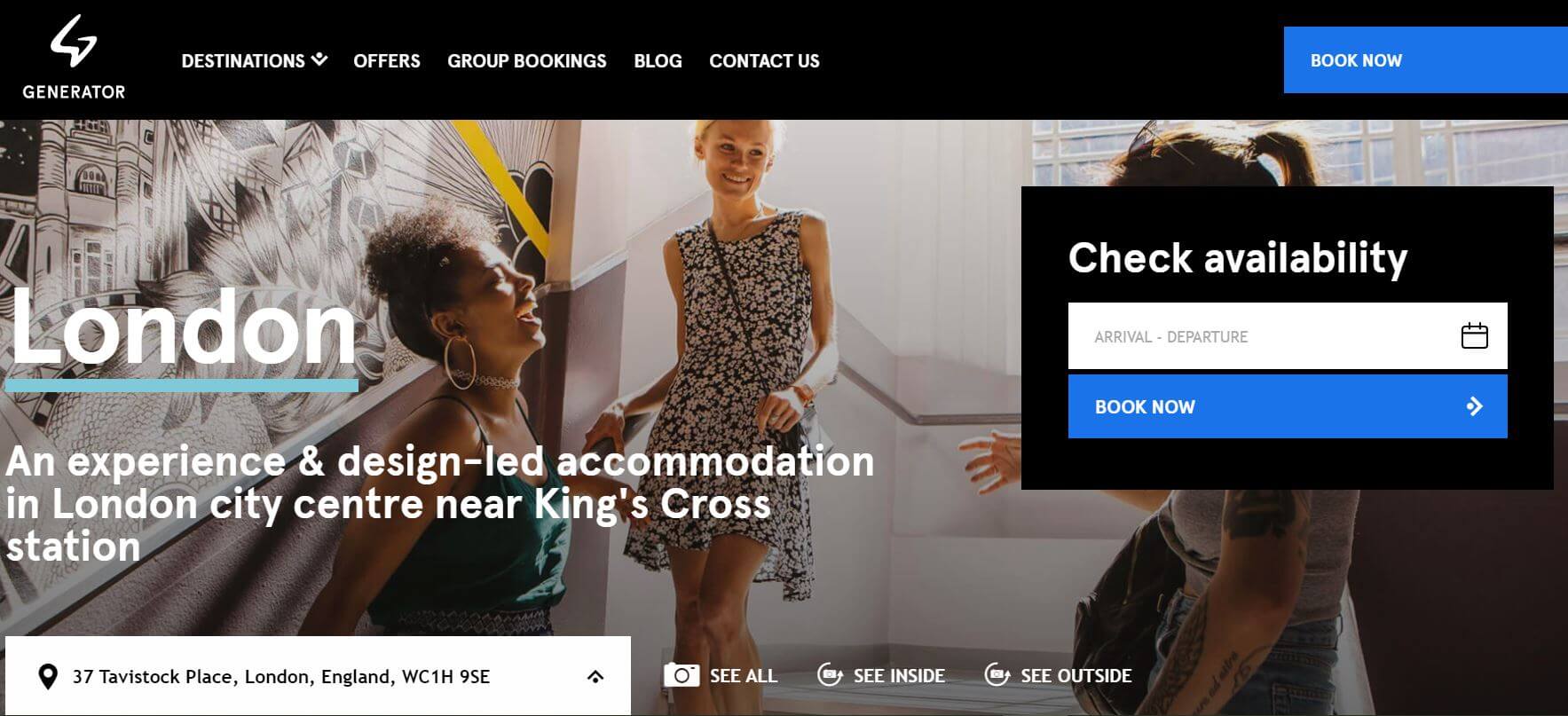
This home page ticks all the boxes: it captures attention, has a clear message and makes it easy to book a room.
About page
The about page is one of the most important pages on your website but it’s often underestimated and/or forgotten. That’s unfortunate because a study showed that on average 52% of site visitors will check out this page. This means you’re leaving site visitors hanging and miss out on direct bookings if you neglect this page.
Let’s look at how you can avoid this mistake make the most of your about page.
You may have heard somewhere that the about page is not really about you, but rather your site visitor. That’s not how I’d put it.
Instead, think about it this way: the about page should be about you but stay relevant to guests.
What does that mean?
The about page is where people go to learn more about your property as a whole and to find information that’s not available anywhere else. But they’re not just looking for general details. Rather, they want information that makes your hotel more interesting, intriguing, or inspiring to them.
Find these aspects by asking yourself:
- What could you tell potential guests about your property that would pique their interest even more than all the great things they’ve seen on the rest of the website?
- Which details about your hotel are important to a potential guest’s booking decision?
Possible answers include:
- Special location (on the top floors of a famous building, on a secluded beach, at 3000 meters of altitude…)
- Unique service offer (something nobody else in the area does)
- Award-winning amenities (e.g. Michelin-starred restaurants or a top-notch spa)
- Distinctive (possibly award-winning) design
- Interesting history (Is your hotel in an old palace or castle? Is the region of special importance?)
- Awards, accolades and media features
- Other quirky details people will enjoy and that make your hotel feel more relatable to guests
Really think about what could help you build a connection with site visitors here. Then create a short introduction to your hotel that reveals its essence and convinces your site visitors that they’ve come to the right place.
Finish your about page strong with a call to action that encourages your readers to take the next step. This should include the options of booking via your site and the chance to learn more about your rooms before making their final decision.
Description and information pages (for rooms, F&B, MICE, spa, special offers)
What to include in your hotel website’s information pages
As the name says, a description or information page provides details on a topic your site visitors want to know more about.
For your hotel website, you would create information pages for your rooms and suites, your dining venues, MICE facilities, spa and leisure amenities, special offers and possibly your surroundings.
Think about the questions people will have when they come to these pages when you write the text for them. Ask your reservations team which questions get asked most. Then include the answers in your description pages and update them whenever you change your offering.
How to write and lay out your information pages
The key to a good information page is providing clear, relevant, no-nonsense info. Be short, to the point and add relevant photos to help drive home your point.
Start with a brief intro text that paints a picture and allows your guests to imagine themselves at your property. Appeal to the heart first by focusing on what guests really want, i.e. the benefits your hotel offers (not just the features).
When guests look for a hotel with a pool, they don’t just want a pool (the feature). What they really want is what the pool promises (the benefits):
- a relaxing afternoon in the sun
- a refreshing morning swim
- the chance to work out while on the road
The information you highlight most prominently depends on your target audience. Business guests want to know about:
- Your high-speed Wi-Fi
- Whether the room has a good desk for productive work
- If there’s an iron in the room
Families are more interested in:
- Options for extra beds or baby cots
- Connecting rooms for a smooth family trip
- Child discounts on meals
Once you’ve set the mood, drive home your point by adding feature information that’s important but doesn’t have the same emotional value as the benefits. Use bullet points to make it easy to read and browse.
At the end of the description page, ask yourself: what would the reader like to do or know now?
At the bottom of a room description page, add a button to ‘book this room’ and to ‘view other rooms and suites’ for those who want to compare options. Offer a chance to book a table or check other dining options on your restaurant information page.
Thank you
That brings us to the end of this guide to hotel website copywriting…
I hope it helped you understand how to craft convincing copy and create hotel website copy your guests will love.
Now, the real fun begins because…
…it’s your turn to apply what you learned and revamp your copy!
By applying the points I outlined above, you’ll get the most important things right on your website and increase your chances of generating more direct bookings from your site visitors.
If you have questions, comments, or feedback, I’d love to hear it below or via email!
For more tips on hotel website copywriting, check out my video training on the top four common mistakes hotels make on their websites.
.
Download this guide now and get your hotel website copywriting up to speed 👇🏼


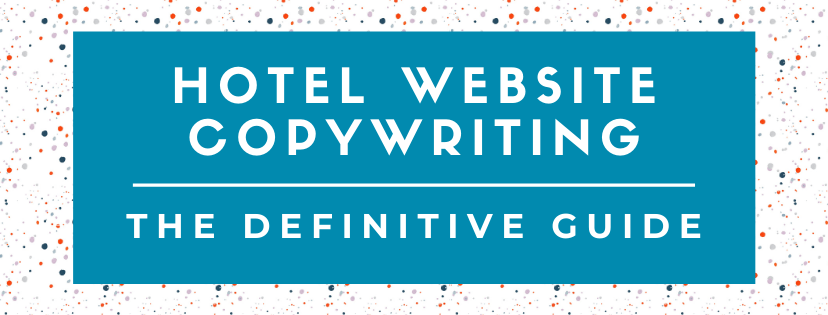
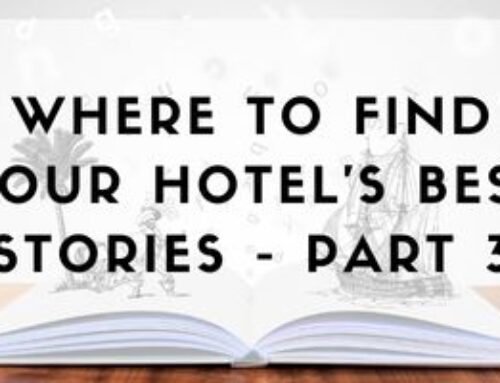

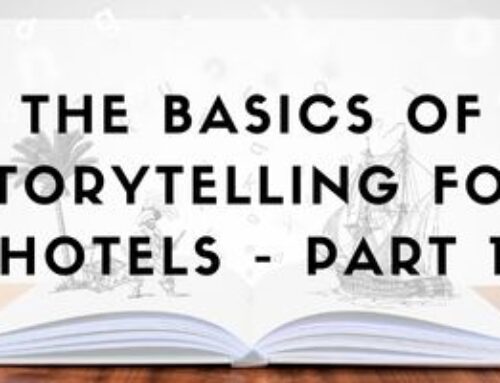
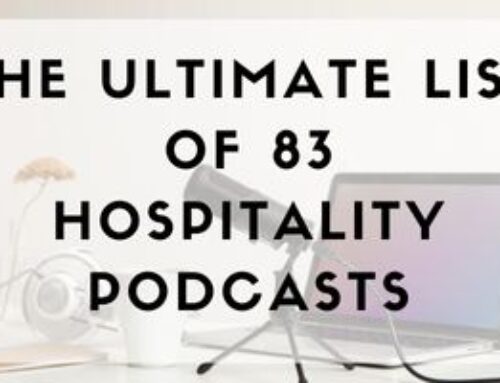

Great post Juliana, you’ve managed to cover an impressive amount of ground here. Loads of useful tips for hotels!
Thank you, Richard. Glad to hear you like it 🙂